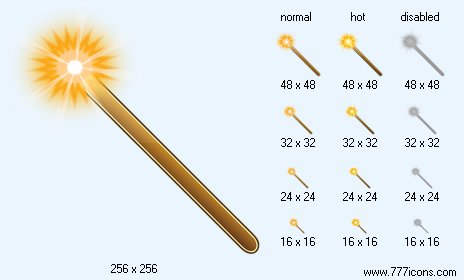


|
| ||||||||
|
|
Wizard Icon |
|
Image sizes: 256x256, 48x48, 32x32, 24x24, 16x16, 512x512
File formats: BMP, GIF, PNG, ICO
Using The Correct File Format For Your Icons.
There are innumerable image formats that should be put to use for storing icons and for a relatively raw web creator this can quickly lead to a sizable problem because you will have to know how to use a specific file format, offered in this article is an explanation of the advantages and drawbacks of some well known file formats.If you are interested in graphic making or wish to create pictorial depictions for your site, it is imperative to find out more about the different image file formats and their features so that you can make use of the appropriate file format for graphics. Normally used formats for graphics are JPEG, PNG and GIF, each one of these file formats boasts of a fair share of advantages so lets look at the advantages and disadvantages of utilizing these file formats, the type of image that should live up to the requirements of your website and optimizing your icons for the internet.
GIF: The full form is Graphics Interchange Format; the image format is by far the most popular file type. The popularity of this format can be attributed small size which makes uploading a breeze. Unlike JPEG, data is not lost in this format ; this equates to the fact that you can save the graphic in a smaller size without deteriorating the quality of the picture. Since GIF supports transparency in graphics, it is one of the most suitable file formats for icon making. Unlike the other image formats, scope for animation is also possible in GIF. If you wish to consider GIF image optimization, it is important to keep the size of the image small; it would be best that you choose a 32 color palette to get the least possible size.
JPEG: This stands for Joint Photographic Experts Group; the file format is usually called JPG and is usually incorporated on websites. One of the main pros of incorporating this type of file is that you will be able to save the pictures in true color that offers you a palette of 16 million colors; this makes the image type appropriate for storing photos and graphics that have detailed color work. One of the cons of utilizing JPG is the information loss that will have to be tackled every time the picture is stored; this points to the fact that the image is marred by compromised clarity and a lot of details may be lost. Unlike other file formats such as GIF, support for transparency is not provided in this file format. If you are utilizing a superior image editor like the Adobe Photoshop, you can choose the quality and the size of the JPG file ; however, it is imperative to realize that a lower resolution equates to a smaller size, which is simple to upload.
PNG: Is stands for Portable Network Graphics and is a fairly fresh file format. PNG is available in two versions types; PNG-8 which has a 8 bit color format and the PNG-24 which has 24 color graphics. PNG-8 can compress pictures with wonderful detail and without the usual loss of data experienced in GIF files; this gives improved image quality and fast uploads. But, PNG-24 is not as efficient as JPG when you need to save pictures and other illustrations that merit the use of a wider color palette. The format is not limited by loss; this means that the image maintains its clarity and quality. PNG-24 offers the transparency feature and you can utilize varying degrees of transparency in this format. With this type of file the images are professional looking because they do not have the tell tale jagged edges when inserted against a background with contrasting colors like GIF files.
Copyright © 2006-2022 Aha-Soft. All rights reserved.
|

